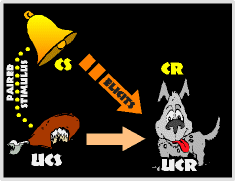Classical Conditioning |
 We use the term classical (or Pavlovian) conditioning to describe one type of associative learning in which there is no contingency between the behavior (BH) of an animal and a biologically relevant event (unconditioned stimulus, US). Instead, the US is contingent upon an initially neutral environmental event (conditioned stimulus, CS). This situation resembles most closely the archetypal experiment from I. Pavlov in the 1920s, where he trained dogs to associate a tone with a food-reward (see figure). In such experiments, the subject initially shows weak or no response to a conditioned stimulus (CS, e.g. a tone), but a measurable unconditioned response (UR, e.g. saliva production) to an unconditioned stimulus (US, e.g. food). In the course of the training, the CS is repeatedly presented together with the US; eventually the subject forms an association between the US and the CS. In a subsequent test-phase, the subject will show the conditioned response (CR, e.g. saliva production) to the CS alone, if such an association has been established and memorized. Such "Pavlovian" conditioning is opposed to instrumental or "operant conditioning", where producing a behavior controls the US presentations. You can learn more about the differences between classical and operant conditioning in my general introduction into simple associative learning. We have a comprehensive collection of documents explaining the basic concepts of classical conditioning in a more detailed way. |